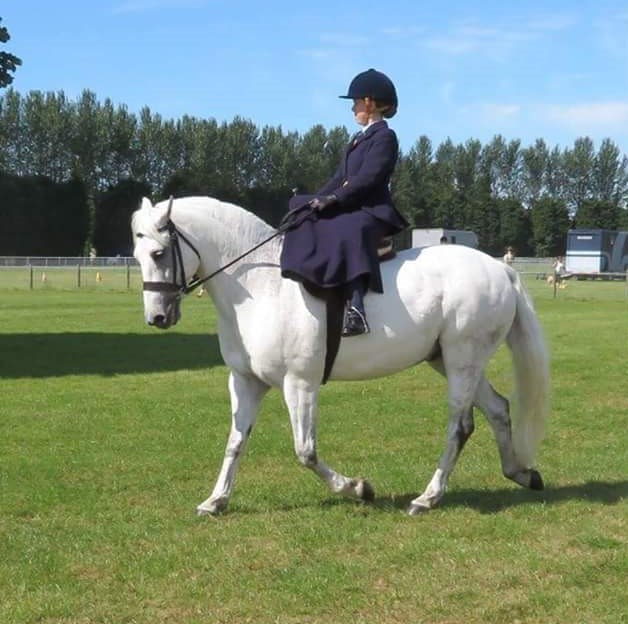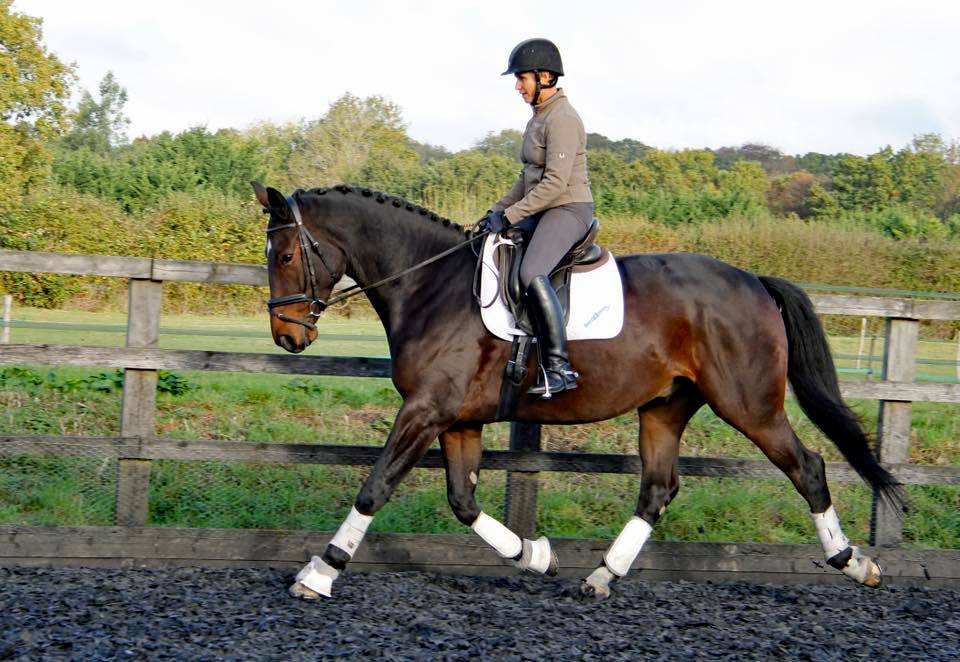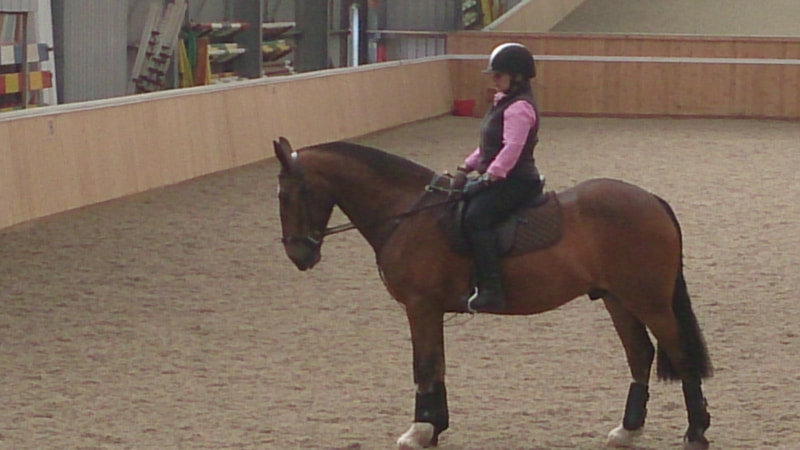Dressage Snaffles
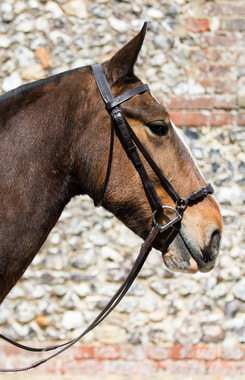
In order to have a really good result Bitting a variety of Horses you have to have a good range of Dressage legal bits to choose from
To fit horses of different
ages
sensitivities
conformation
levels of training
and then to consider the riders
hands on the end of the reins
abilities
fitness and training
With the right bit it is possible to encourage the horse to go to the correct place in the bridle by creating comfort, release and reward, making it quite clear where the most comfortable place in the bridle is.
A well made well balanced bit should aid the horse and rider, not hinder and make the Horse uncomfortable and less responsive
A well made and designed bit should be engineered to have release and reward built into the design so the riders hand can maintain a light rein contact and not have to constantly give away too much contact to compensate for the bit
Informed Designs has 10 different Snaffle mouthpieces in 4 diameters on 8 cheeks
Which gives a lot of potential when trying to strive for perfection in your Bitting Choices
To fit horses of different
ages
sensitivities
conformation
levels of training
and then to consider the riders
hands on the end of the reins
abilities
fitness and training
With the right bit it is possible to encourage the horse to go to the correct place in the bridle by creating comfort, release and reward, making it quite clear where the most comfortable place in the bridle is.
A well made well balanced bit should aid the horse and rider, not hinder and make the Horse uncomfortable and less responsive
A well made and designed bit should be engineered to have release and reward built into the design so the riders hand can maintain a light rein contact and not have to constantly give away too much contact to compensate for the bit
Informed Designs has 10 different Snaffle mouthpieces in 4 diameters on 8 cheeks
Which gives a lot of potential when trying to strive for perfection in your Bitting Choices
The hand test to access how much close the action has
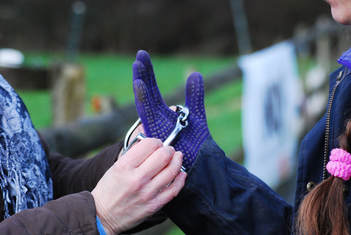
This is on my website but its worth reminding people of a simple check to see if the bit you have is a comfortable as you think
When you are assessing the comfort of the bit your horse is wearing despite the advertising and the claims that some companies make just try this simple test
Face a friend and hold your hand up knuckles facing them Get them to place your horses bit around your hand and get them to pull the bit closed
Your hand represents your Horses lower jaw and your friends hands represent your hands on the end of the reins
If the bit you are using on your horse pinches your hand with finger pressure imagine how it feels to your horse when you are applying more pressure with upper body weight applied to your signal
Now decide whether the bit you have on your Horse is fair, comfortable and fits your horses mouth conformation well and therefore gives him or her the right signals and reward or whether it is restrictive and pinches.
Also look at your bit critically is it symmetrical and even all through the mouthpiece a Horse will not go evenly forward into your hands if the mouthpiece of its bit is uneven and asymmetrical.
When you are assessing the comfort of the bit your horse is wearing despite the advertising and the claims that some companies make just try this simple test
Face a friend and hold your hand up knuckles facing them Get them to place your horses bit around your hand and get them to pull the bit closed
Your hand represents your Horses lower jaw and your friends hands represent your hands on the end of the reins
If the bit you are using on your horse pinches your hand with finger pressure imagine how it feels to your horse when you are applying more pressure with upper body weight applied to your signal
Now decide whether the bit you have on your Horse is fair, comfortable and fits your horses mouth conformation well and therefore gives him or her the right signals and reward or whether it is restrictive and pinches.
Also look at your bit critically is it symmetrical and even all through the mouthpiece a Horse will not go evenly forward into your hands if the mouthpiece of its bit is uneven and asymmetrical.
Think Mouthpiece first and then cheek piece
When you are considering re Bitting your Horse all elements of the bit are important firstly the mouthpiece because that is inside the Horses mouth either sitting comfortably allowing the Horse to close its mouth properly and swallow freely and giving understandable signals that the Horse can readily respond to and very importantly feel a reward from when the frame or the tempo is achieved
Or not sitting well and not following the conformation of the inside of the mouth and making the Horse unable to settle and be comfortable with the bit
And then the next consideration is the cheek which cheek do you choose to complement the mouthpiece to give you the right signals and the best control
Not all the mouthpieces come on all cheeks sometimes because its hard to have every combination and sometimes on purpose as some mouthpieces simply do not work with some cheek pieces
Or not sitting well and not following the conformation of the inside of the mouth and making the Horse unable to settle and be comfortable with the bit
And then the next consideration is the cheek which cheek do you choose to complement the mouthpiece to give you the right signals and the best control
Not all the mouthpieces come on all cheeks sometimes because its hard to have every combination and sometimes on purpose as some mouthpieces simply do not work with some cheek pieces
Snaffles
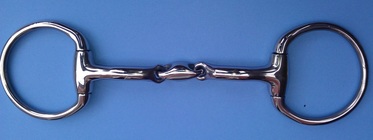
Harmony Eggbutt
The Harmony mouthpiece actively encourages a horse to move towards and push his tongue forward to the contact .As the reins are used together the whole mouthpiece wraps around the tongue and lower jaw, taking in the whole of the tongue the sides of the lips and the sides of the bars and the sides of the lips in a perfect hoop. As the Round Lozenge is the correct length and the joints are neat and non invasive the Horse should move forward into the contact. Both branches of the bit are curved forward to go with the shape of the Horses tongue and roof of the mouth a. Good young Horse starter Bit.
Very useful for Horses or Ponies that are uncomfortable with
· A large joint or joints
· Large long plates or lozenges
· That block on one side as you flex or turn
The Harmony mouthpiece actively encourages a horse to move towards and push his tongue forward to the contact .As the reins are used together the whole mouthpiece wraps around the tongue and lower jaw, taking in the whole of the tongue the sides of the lips and the sides of the bars and the sides of the lips in a perfect hoop. As the Round Lozenge is the correct length and the joints are neat and non invasive the Horse should move forward into the contact. Both branches of the bit are curved forward to go with the shape of the Horses tongue and roof of the mouth a. Good young Horse starter Bit.
Very useful for Horses or Ponies that are uncomfortable with
· A large joint or joints
· Large long plates or lozenges
· That block on one side as you flex or turn
- or are very busy in the mouth
- or have been pinched with a mouthpiece that has a severe close to the action
- or do not draw the contact forward
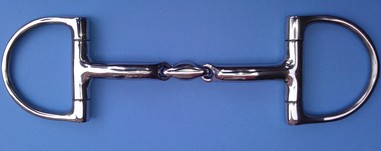
Harmony D Cheek
Very useful for
Horses that are doing lots of jobs and need a comfortable forward encouraging mouthpiece with a supportive cheek
Horses that are young and need an all round training bit to start in and then to carry on with work
Horses that are being trained from the floor and need a simple comfortable bit with support and release and reward
Very useful for
Horses that are doing lots of jobs and need a comfortable forward encouraging mouthpiece with a supportive cheek
Horses that are young and need an all round training bit to start in and then to carry on with work
Horses that are being trained from the floor and need a simple comfortable bit with support and release and reward
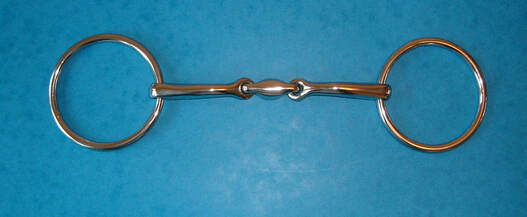
Harmony Loose Ring
The Harmony mouthpiece actively encourages a horse to move towards and push his tongue forward to the contact .As the reins are used together the whole mouthpiece wraps around the tongue and lower jaw, taking in the whole of the tongue the sides of the lips and the sides of the bars and the sides of the lips in a perfect hoop. As the Round Lozenge is the correct length and the joints are neat and non invasive the Horse should move forward into the contact. Both branches of the bit are curved forward to go with the shape of the Horses tongue and roof of the mouth a. Good young Horse starter Bit.
Very useful for Horses or Ponies that are uncomfortable with
· A large joint or joints
· Large long plates or lozenges
· That block on one side as you flex or turn
· or are very busy in the mouth
· or do not draw the contact forward
The Harmony mouthpiece actively encourages a horse to move towards and push his tongue forward to the contact .As the reins are used together the whole mouthpiece wraps around the tongue and lower jaw, taking in the whole of the tongue the sides of the lips and the sides of the bars and the sides of the lips in a perfect hoop. As the Round Lozenge is the correct length and the joints are neat and non invasive the Horse should move forward into the contact. Both branches of the bit are curved forward to go with the shape of the Horses tongue and roof of the mouth a. Good young Horse starter Bit.
Very useful for Horses or Ponies that are uncomfortable with
· A large joint or joints
· Large long plates or lozenges
· That block on one side as you flex or turn
· or are very busy in the mouth
· or do not draw the contact forward
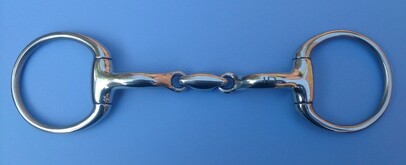
Liberty Eggbutt
The Liberty has the most generous forward curve of all my Eggbutt snaffles and is new to the range for 2019 I have researched how much or how little curve you need to help different Horses to be able to respond well and after prototyping this bit it has come into stock and I am so pleased with the results
It has really soft curve forward and feels very even into the riders hands
Very useful for Horses that have been
The Liberty has the most generous forward curve of all my Eggbutt snaffles and is new to the range for 2019 I have researched how much or how little curve you need to help different Horses to be able to respond well and after prototyping this bit it has come into stock and I am so pleased with the results
It has really soft curve forward and feels very even into the riders hands
Very useful for Horses that have been
- Poorly bitted in the past and are frightened of their mouths
- Horses that have been started on head pressures and are now being introduced to a bit
- Young Horses bitted for the first time
- Any Horse that is not strong and needs to be bitted very comfortably and forward
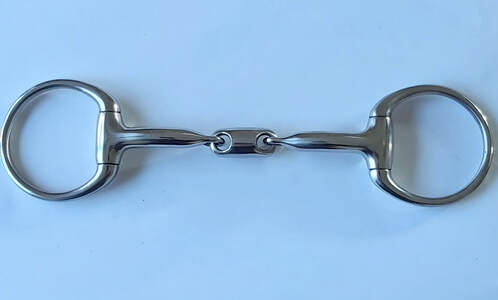
Precision Eggbutt
- The Precision mouthpiece is a combination of a generous round curve to the branches of the mouthpiece small non invasive joints and an Oval Lozenge that is rounded on the roof of the mouth and Oval on the tongue side
The feel for the Horse and into the Riders hand is one of encouraging the Horse forward into the bit but when it gets there they should lighten up and flex to the Riders signals
- Very useful for Horses that need
The confidence to go forward into the action of the Bit
Can be a bit inflexible when they reach the end of the Rein
Need clear signals from the bit with out any restriction or Pinch - Or a young Horse that is moving forward in its training and has got a little too forward in the contact

Precision D Cheek
- The Precision mouthpiece is a combination of a generous round curve to the branches of the mouthpiece small non invasive joints and an Oval Lozenge that is rounded on the roof of the mouth and Oval on the tongue side
The feel for the Horse and into the Riders hand is one of encouraging the Horse forward into the bit but when it gets there they should lighten up and flex to the Riders signals
- Very useful for Horses that need
The confidence to go forward into the action of the Bit
Can be a bit inflexible when they reach the end of the Rein
Need clear signals from the bit with out any restriction or Pinch - Or a young Horse that is moving forward in its training and has got a little too forward in the contact
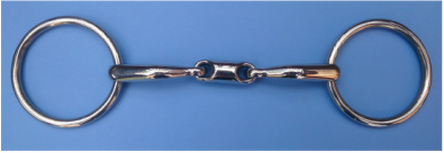
Response Loose Ring
The Response mouthpiece encourages a horse to move towards the bit but because of the structure of the Oblong lozenge and the positioning of the joints it discourages the Horse from getting too strong or set on the mouthpiece. As the reins are used together the whole mouthpiece is pulled around the tongue and lower jaw with a really comfortable no pinch wrap effect , the mouthpiece has a structured feel in the centre of the tongue to dissuade the horse from leaning on the bit. The Lozenge is small neat and stays in the centre of the tongue and does not interfere with the edge of the tongue or the bars of the mouth This is a Oblong lozenge and not a plate a plate would have to be flat on both sides
Very useful for Horses or Ponies that need to
· Pay more heed to the mouthpiece
· Are a little strong and too forward into the bit
· That block on one side as you flex or turn
· That are a little heavy in the hands
The Response mouthpiece encourages a horse to move towards the bit but because of the structure of the Oblong lozenge and the positioning of the joints it discourages the Horse from getting too strong or set on the mouthpiece. As the reins are used together the whole mouthpiece is pulled around the tongue and lower jaw with a really comfortable no pinch wrap effect , the mouthpiece has a structured feel in the centre of the tongue to dissuade the horse from leaning on the bit. The Lozenge is small neat and stays in the centre of the tongue and does not interfere with the edge of the tongue or the bars of the mouth This is a Oblong lozenge and not a plate a plate would have to be flat on both sides
Very useful for Horses or Ponies that need to
· Pay more heed to the mouthpiece
· Are a little strong and too forward into the bit
· That block on one side as you flex or turn
· That are a little heavy in the hands
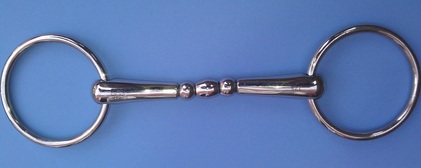
Doubler Loose Ring
The Doubler mouthpiece instead of having large wide joints that do not fit well between the top of the Horses tongue and the roof of the mouth this bit has small ball bearings and a very small barrel. As the reins are used together the whole mouthpiece is pulled around the tongue and lower jaw, the mouthpiece has a structured feel in the centre of the tongue to dissuade leaning on the bit.
Very useful for Horse or Ponies that need to
· Pay more heed to the mouthpiece
· Are a little strong and too forward into the bit
· That block on one side as you flex or turn
· That are a little heavy in the hands
The Doubler mouthpiece instead of having large wide joints that do not fit well between the top of the Horses tongue and the roof of the mouth this bit has small ball bearings and a very small barrel. As the reins are used together the whole mouthpiece is pulled around the tongue and lower jaw, the mouthpiece has a structured feel in the centre of the tongue to dissuade leaning on the bit.
Very useful for Horse or Ponies that need to
· Pay more heed to the mouthpiece
· Are a little strong and too forward into the bit
· That block on one side as you flex or turn
· That are a little heavy in the hands

Attention Eggbutt
The Attention mouthpiece Is a curved mouthpiece with a Flat link in the middle so often French Link Style plates can be so long that the joints and even the plate interfere with the edge of the Horses tongue and the bars of the mouth and the really long ones can even end up with the joints in the corner of the lips
A Horse is never going to respond well to a joint scraping into an area the hurts
The Attention has a purposely small plate to keep the signals in the centre of the tongue where they are of the most use
Very useful of Horses and Ponies that need to
Be a little higher in the frame
Be lighter in the Hand
Be more respectful of the action of the bit
The Attention mouthpiece Is a curved mouthpiece with a Flat link in the middle so often French Link Style plates can be so long that the joints and even the plate interfere with the edge of the Horses tongue and the bars of the mouth and the really long ones can even end up with the joints in the corner of the lips
A Horse is never going to respond well to a joint scraping into an area the hurts
The Attention has a purposely small plate to keep the signals in the centre of the tongue where they are of the most use
Very useful of Horses and Ponies that need to
Be a little higher in the frame
Be lighter in the Hand
Be more respectful of the action of the bit
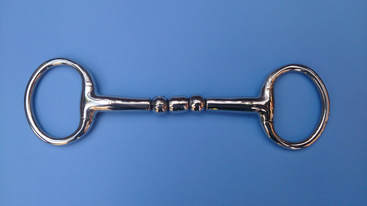
Doubler Eggbutt
The Doubler mouthpiece instead of having large wide joints that do not fit well between the top of the Horses tongue and the roof of the mouth this bit has small ball bearings and a very small barrel. As the reins are used together the whole mouthpiece is pulled around the tongue and lower jaw, the mouthpiece has a structured feel in the centre of the tongue to dissuade leaning on the bit.
Very useful for Horse or Ponies that need to
· Pay more heed to the mouthpiece
· Are a little strong and too forward into the bit
· That block on one side as you flex or turn
· That are a little heavy in the hands
The Doubler mouthpiece instead of having large wide joints that do not fit well between the top of the Horses tongue and the roof of the mouth this bit has small ball bearings and a very small barrel. As the reins are used together the whole mouthpiece is pulled around the tongue and lower jaw, the mouthpiece has a structured feel in the centre of the tongue to dissuade leaning on the bit.
Very useful for Horse or Ponies that need to
· Pay more heed to the mouthpiece
· Are a little strong and too forward into the bit
· That block on one side as you flex or turn
· That are a little heavy in the hands
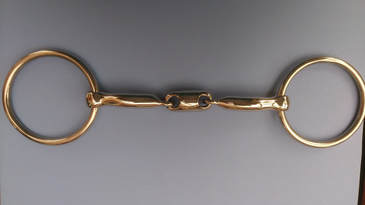
Precision Loose Ring
The Precision mouthpiece is a combination of a generous round curve to the branches of the mouthpiece small non invasive joints and an Oval Lozenge that is rounded on the roof of the mouth and Oval on the tongue side
The feel for the Horse and into the Riders hand is one of encouraging the Horse forward into the bit but when it gets there they should lighten up and flex to the Riders signals
Very useful for Horses that need
The confidence to go forward into the action of the Bit
Can be a bit inflexible when they reach the end of the Rein
Need clear signals from the Bradoon with out any restriction or Pinch
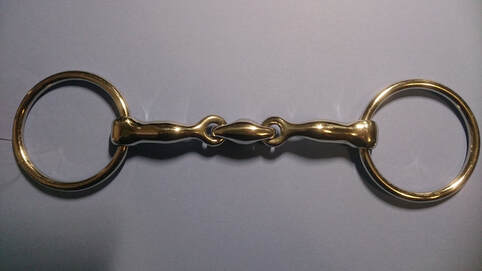
Contour Loose Ring Snaffle
The Contour mouthpiece is a 13mm generously curved loose ring Oval Lozenge Snaffle with a slightly longer Lozenge covered more area inside the mouth designed to encourage the Horse forward into the contact
Very good for
Horses that like the slightly thicker mouthpiece
Horses that are reluctant to take the contact forward
Horses that have been in restrictive mouthpieces and have tongue issues
Horses that you want to create a more consistent contact with
The Contour mouthpiece is a 13mm generously curved loose ring Oval Lozenge Snaffle with a slightly longer Lozenge covered more area inside the mouth designed to encourage the Horse forward into the contact
Very good for
Horses that like the slightly thicker mouthpiece
Horses that are reluctant to take the contact forward
Horses that have been in restrictive mouthpieces and have tongue issues
Horses that you want to create a more consistent contact with
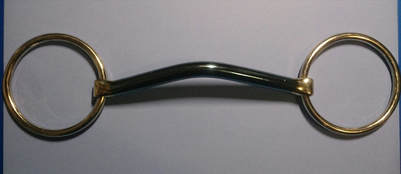
Symmetry ML Loose Ring
The Symmetry ML Loose ring is a variation on my Symmetry Eggbut Snaffle
it has an upwards as well as a forward curve to the mouthpiece
Very good for
Horses that do not like any jointed bits
Horses that do not like any collapse to the action of a bit
Horses that go well in a Mullen Pelham and you are looking for a Dressage Legal alternative
Horses that are busy in the mouth and need a still comfortable mouthpiece
The Symmetry ML Loose ring is a variation on my Symmetry Eggbut Snaffle
it has an upwards as well as a forward curve to the mouthpiece
Very good for
Horses that do not like any jointed bits
Horses that do not like any collapse to the action of a bit
Horses that go well in a Mullen Pelham and you are looking for a Dressage Legal alternative
Horses that are busy in the mouth and need a still comfortable mouthpiece

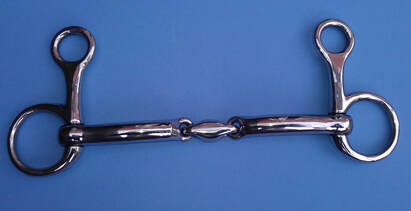
The Harmony mouthpiece actively encourages a horse to move towards and push his tongue forward to the contact .As the reins are used together the whole mouthpiece wraps around the tongue and lower jaw, taking in the whole of the tongue the sides of the lips and the sides of the bars and the sides of the lips in a perfect hoop. As the Round Lozenge is the correct length and the joints are neat and non invasive the Horse should move forward into the contact. Both branches of the bit are curved forward to go with the shape of the Horses tongue and roof of the mouth unlike some Lozenge Snaffles that really pinch the Horses lower jaw . Good young Horse starter Bit.
Very useful for Horses or Ponies that are uncomfortable with
· A large joint or joints
· Large long plates or lozenges
· That block on one side as you flex or turn
· or are very busy in the mouth
Very useful for Horses or Ponies that are uncomfortable with
· A large joint or joints
· Large long plates or lozenges
· That block on one side as you flex or turn
· or are very busy in the mouth

